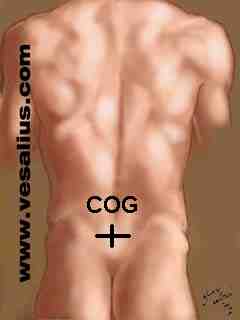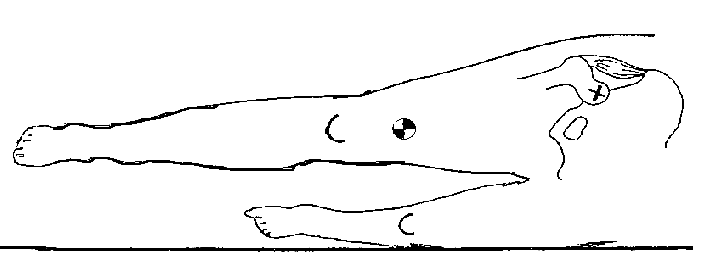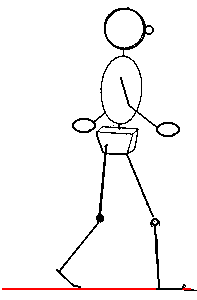it relates mass to concepts like WEIGHT (W) and GRAVITY:
F=ma
Analogously, W=mg
MASS AND WEIGHT ARE NOT THE SAME
Weight is an example of a FORCE, specifically, the force of gravity acting at or near the surface of the Earth.
Just as force is the algebraic product of mass and acceleration,
F=ma
Weight is a gravitational force that is the product of a mass and a constant gravitational acceleration (g), so that
W=mg
The symbol g customarily signifies gravitational acceleration. Near the surface of the Earth, where we perform most biomechanical analyses, g is equal to:
32 feet per second per second (32 ft/sec2) OR
9.8 meters per second per second (9.8 m/sec2)
Sue Eggling of Clackamas Community College provides basic background on the distinction between mass and weight. You can also review information on physics terms that relate to kinetics (the study of the forces that produce movement)
CENTER OF MASS (CENTER OF GRAVITY)
Physicists distinguish between these terms, but we won't.
Definition: (geometric) point around which every particle of a body's mass is equally distributed. A body behaves as if its entire mass acts or is acted upon at its center of gravity.
INSTANCES IN WHICH WE'LL BE CONCERNED WITH MASSES IN THE HUMAN BODY:
- WHOLE BODY MASS
- SEGMENTAL MASS
- SUPERINCUMBENT MASS
WHOLE BODY
COG located at sacral promontory, anterior to S2 (PSIS), at 55% of body height

| |
|---|
SEGMENTAL
We think of the body as a series of segments linked by perfectly hinged joints.

The COG of the entire lower extremity, the body segment that lies distal to the hip (pelvi-femoral) joint, is located just proximal to the knee (Smith, Weiss, & Lehmkuhl, 1996, p.55). This information comes from an anthropometric table that specifies typical segmental masses and centers of gravity.
The University of Sydney (Australia) physiotherapy program provides an online version of Winter's (1979) much cited anthropometric table.
SUPERINCUMBENT (that which lies on top)
Therapists often analyze weight-bearing activities where, for example, a person stands and controls a mass atop the hip joint.
WHETHER A MASS IS STABLE OR MOBILE ...
depends on its size, the location of its COG, the size of the mass' base of support (BOS), and the location of the COG's vertical projection into that base of support (Smith, Weiss, & Lehmkuhl, 1995, p.51).
| | STABILITYMOBILITY
masslargesmall
position of COGlow
high
size of BOSlarge small
vertical projection of COGto point near center of BOSto point near boundary of BOS
| | | | | | | | | | | | | |
References:
Smith, L.K., Weiss, E.L., & Lehmkuhl, L.D. (1995). Brunnstrom's clinical kinesiology. (5th ed.). Philadelphia: F.A. Davis.
Winter, D.A. (1979). Biomechanics of Human Movement. New York: John Wiley & Sons.


